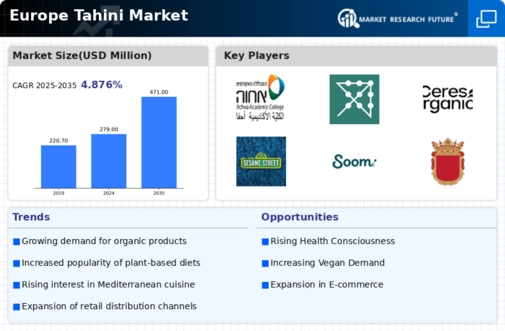The Europe Tahini Market is experiencing considerable growth, driven by rising consumer awareness regarding health and nutrition, along with an increasing demand for plant-based food products. Various manufacturers are expanding their product portfolios and enhancing their distribution channels to capture a larger share of this market. This competitive landscape is defined by the presence of both established global brands and regional players, each vying for market dominance. Companies are focusing on various strategies, such as innovation in product formulations, branding initiatives, and sustainability practices, to appeal to a growing health-conscious consumer base.
The competition is also heightened by the increasing popularity of Middle Eastern and Mediterranean cuisine, which encourages the incorporation of tahini in various culinary applications, leading to a dynamic environment for growth and market entry challenges. Gaea Products has established a strong foothold in the Europe Tahini Market through an unwavering commitment to quality and the promotion of traditional Mediterranean diets. The brand is recognized for its premium range of tahini products, which are produced using high-quality sesame seeds sourced from sustainable farms.
Gaea’s presence in Europe is marked by effective distribution channels that ensure its products reach consumers through supermarkets, specialty stores, and online platforms. One of the significant strengths of Gaea Products lies in its strong brand reputation for health-oriented products, appealing to consumers who prioritize quality ingredients.
The brand’s dedication to sustainability and organic farming practices further enhances its appeal, allowing it to maintain a competitive edge in a rapidly evolving market. Achva has also carved a notable space in the Europe Tahini Market by offering a diverse range of tahini products tailored to various culinary preferences. The company is distinguished by its innovative product line that includes traditional tahini as well as flavored variants, catering to a broader spectrum of consumer tastes. Achva's commitment to quality and adherence to food safety standards have earned it a loyal customer base in Europe.
The company’s strengths include an established distribution network that emphasizes relationships with local retailers and e-commerce platforms. Achva is also known for its strategic mergers and partnerships with local food companies to enhance its market presence, making it a formidable player in the European scene. The company's efforts in marketing and promotion, combined with its focus on product innovation, continue to drive its growth and bolster its position among competitors in the tahini market across Europe.


















